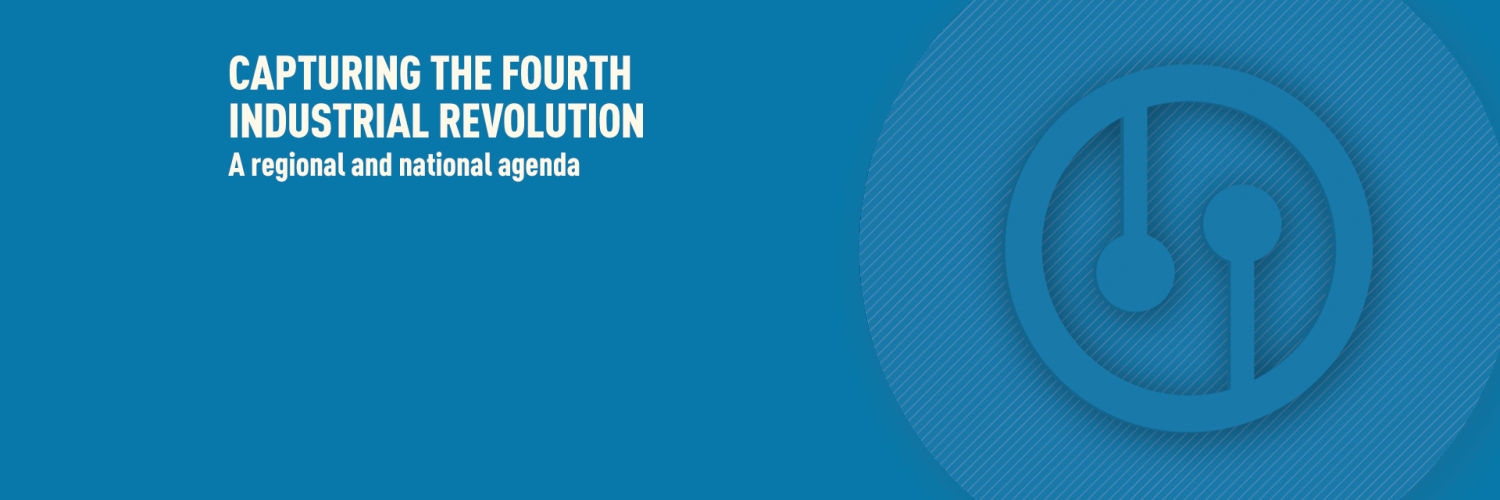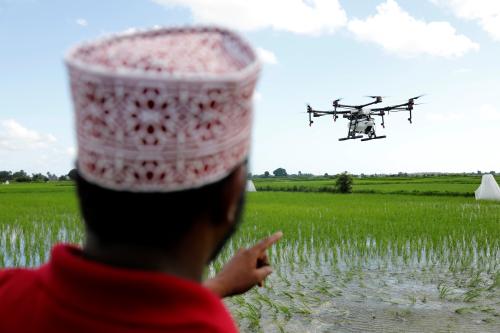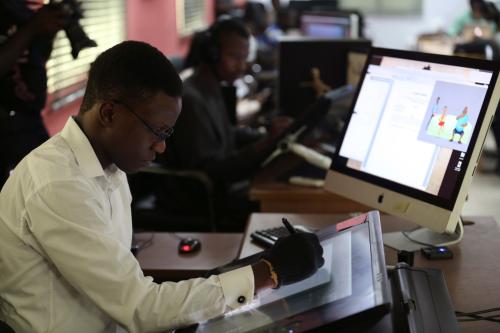Below is Chapter 5 of the Foresight Africa 2020 report, which explores six overarching themes that provide opportunities for Africa to overcome its obstacles and spur inclusive growth. Download the paper to see the contributing viewpoints from high-level policymakers and other Africa experts.

The Fourth Industrial Revolution (4IR)—characterized by the fusion of the digital, biological, and physical worlds, as well as the growing utilization of new technologies such as artificial intelligence, cloud computing, robotics, 3D printing, the Internet of Things, and advanced wireless technologies, among others—has ushered in a new era of economic disruption with uncertain socio-economic consequences for Africa.1 However, Africa has been left behind during the past industrial revolutions. Will this time be different?
So far, it does not appear that Africa has yet claimed the 21st century,2 as it still lags behind in several indicators essential for a successful digital revolution (see Figure 5.1).3
Improvements in Africa’s ICT sector have been largely driven by expanding mobile digital financial services: The region had nearly half of global mobile money accounts in 2018 and will see the fastest growth in mobile money through 2025.
But artificial intelligence (AI) and blockchain are also attracting interest in Africa, as they have the potential to successfully address social and economic challenges there. And there are so many other areas in which 4IR technology can be transformational.
The transformative potential of 4IR in Africa is substantial
Encouraging economic growth and structural transformation
In recent years, the ICT sector in Africa has continued to grow, a trend that is likely to continue. Of late, mobile technologies and services have generated 1.7 million direct jobs (both formal and informal), contributed to $144 billion of economic value (8.5 percent of the GDP of sub-Saharan Africa), and contributed $15.6 billion to the public sector through taxation.4 Digitization has also resolved information asymmetry problems in the financial system and labor market, thus increasing efficiency, certainty, and security in an environment where information flow is critical for economic growth and job creation.
Failure to recognize and capitalize on 4IR opportunities, conversely, will impose considerable risks on African stakeholders: Without attempts to move beyond existing models of innovation, entrepreneurship, and digital growth on the continent, African businesses risk falling further behind, exacerbating the global “digital divide” and lowering their global competitiveness.5 Going beyond the existing models requires discipline in governance to allow an endogenous innovative environment. At the same time, institutions must protect the market through consumer protection laws and regulations that encourage competition.
Fighting poverty and inequality
The spread of digital technologies can empower the poor with access to information, job opportunities, and services that improve their standard of living. AI, the Internet of Things (IoT), and blockchain can enhance opportunities for data gathering and analysis for more targeted and effective poverty reduction strategies. Already, we have witnessed the transformational power of formal financial services through mobile phones, such as M-Pesa, reaching the underserved, including women, who are important drivers for sustainable poverty eradication. These financial services allow households to save in secure instruments to enlarge their asset base and escape cycles of poverty.
Reinventing labor, skills, and production
By 2030, Africa’s potential workforce will be among the world’s largest,6 and so, paired with the needed infrastructure and skills for innovation and technology use, the 4IR represents a massive opportunity for growth. Indeed, the 4IR is dramatically changing global systems of labor and production, requiring that job seekers cultivate the skills and capabilities necessary for adapting rapidly to the needs of African firms and automation more broadly. Already, Africa’s working population is becoming better educated and prepared to seize the opportunities provided by the 4IR: For example, the share of workers with at least a secondary education is set to increase from 36 percent in 2010 to 52 percent in 2030.7
Increasing financial services and investment
Digitization has impacted economic growth through inclusive finance, enabling the unbanked to enter formality through retail electronic payments platforms and virtual savings and credit supply technological platforms.8 More broadly, digitization is enabling entrepreneurs and businesses to rethink business models that are more impactful, sustainable, and connected to other sectors of the economy. For example, with fintech, digitization has gone beyond the financial sector to affect the real sector and households, transforming product designs and business models across market segments.9 Businesses are able to design products and trade online, and individuals are able to operate financial services and payments for shopping and investments. The government is also migrating to online platforms to conveniently provide public services.
Other 4IR technologies are also having impact. For example, in West Africa and Kenya, blockchain has enabled efficient verification of property records and transactions, and expanded access to credit in some previously informal sectors of the economy.10 Since blockchains are immutable, fraud—and thus the cost of risk—is reduced. There are also immense opportunities for job creation in Africa.11 Given the informal sector is estimated to constitute 55 percent of sub-Saharan Africa’s GDP12 (with significant heterogeneity across countries), these tools can be transformational. Their consequences can cascade: Increased financial inclusion contributes to greater capital accumulation and investment, hence potential for employment creation.13
Modernizing agriculture and agro-industries
Africa has yet to harness the full potential of its agricultural sector, and 4IR technologies provide an opportunity to do so. Farming alone accounts for 60 percent of total employment in sub-Saharan Africa, and the food system is projected to add more jobs than the rest of the economy between 2010 and 2025.14 Farm labor and income is especially important in sub-Saharan Africa, where on-farm activities represent almost 50 percent of all rural income in countries like Ethiopia, Malawi, Nigeria, and Tanzania.15 Information on competitive pricing, monitored crop information, disease prevention tips, and disaster mitigation support has the potential to transform the agriculture sector to improve income, production, and demand throughout the continent. Furthermore, as incomes rise across the continent, growing consumer demand for food and beverages will coincide with business-to-business growth in agro-processing.
Ghana-based companies Farmerline and Agrocenta offer farmers mobile and web technology for agricultural advice, weather information, and financial tips. Zenvus, a Nigerian startup, measures and analyzes soil data to help farmers apply the right fertilizer and optimally irrigate farms.16 The “Sparky Dryer,” a dehydration machine invented by a Ugandan engineer, uses biofuel to dehydrate produce and reduce food waste.17 African entrepreneurs and startups are also using the Internet of Things to help farmers optimize productivity and reduce waste through data-driven “precision farming” techniques.
Improving health care and human capital
African countries face numerous health challenges exacerbated by climate change, limited physical infrastructure, and a lack of qualified professionals. 4IR technology can help mitigate these threats and build sustainable health care systems, especially in fragile states.
Mobile technology has become a platform for improving medical data and service delivery: About 27,000 public health workers in Uganda use a mobile system called mTrac to report medicine stocks. The SMS for Life program, a public-private partnership, reduces medicine shortages in primary health care facilities by using mobile phones to track and manage stocks levels of malaria treatments and other essential drugs.18 Rwanda became the first country to incorporate drones into its health care system, using autonomous air vehicles to deliver blood transfusions to remote regions. Technology has also improved disaster response: During the West African Ebola outbreak in 2014, WhatsApp became an easy method of dispersing information, checking symptoms, and communicating under quarantine.19
Illness detection and pharmaceutical production have most immediately benefited from digitization. AI is being slowly implemented in Ethiopia to help medical professionals correctly diagnose cervical cancer and other abnormalities.20 IBM Research Africa is also using AI to determine the optimal methods for eradicating malaria in specific locations and using game theory and deep learning data analytics to diagnose pathological diseases and birth asphyxia.21 (For more on the promise of artificial intelligence in Africa, see the viewpoint on page 69 of the full report).
Strategies for overcoming key challenges facing Africa during the 4IR
Clearly, the 4IR presents significant opportunities as well as challenges for Africa. The key issue for policymakers is how to position their economies to benefit from the 4IR while managing the challenges that it presents. Below are three strategies that leaders should prioritize.
Fixing the labor-skills mismatch
Since creating jobs for the burgeoning youth population is a priority in most African countries, many governments are reluctant to support technologies that threaten existing jobs. Some of the current technologies tend to replace low-skilled workers—of which Africa has an abundance—with higher-skilled workers, constraining participation in the 4IR to economies with relevant skills.22 African governments must invest in education and reskilling programs to ensure that technology supplements, instead of replaces, labor.
Enhancing agile governance for secure, effective management of the 4IR and integration into global value chains
As innovation is at the heart of the 4IR, reinforcing state and institutional capacity to drive and support innovation and create an enabling business environment is essential for success.
A major regulatory challenge involves increasing cybersecurity. Most African countries lack a comprehensive legal framework and institutional capacity to address cybercrime. Instead, efforts to prevent cybercrime are appearing at the more local level or are implemented by private sector actors themselves. For example, between 2015 and 2016, there was a 73 percent increase in Information Security Management System-certified companies, from 129 in 2015 to 224 in 2016, with the majority in South Africa, Nigeria, and Morocco.23 Adopting widely accepted and appropriate norms and regulations, such as these, is a first step to increasing cybersecurity. At the same time, companies should invest in their employees to develop cybersecurity skills and integrate cyber risk protection in their decision making process.
The African Continental Free Trade Agreement offers a unique opportunity to enhance governance around the 4IR. With aligned policies and procedures, the continent can adapt to the rapid changes of the 4IR and leverage it to accelerate participation in global value chains.
More broadly, the 4IR can actually empower service delivery, through, for example, national identification and a new generation of biometrics that can centralize data for a variety of uses and users.
Developing physical and digital infrastructure
Access to advanced technology in Africa is constrained by infrastructure parameters such as lack of electricity and low tele-density, internet density, and broadband penetration.24 As a result, mobile phone and internet use remains low (Figure 5.2). (For more on strategies for upgrading Africa’s ICT infrastructure, see the viewpoint on page 71). Other technological bottlenecks include a lack of standardized application programming interfaces and common data languages for the increased integration of largely self-sufficient systems as well as exposure to the dangers of cyberattacks. Accelerating the physical connectivity of fiber-optic networks as well as the interoperability of virtual platforms is critical not only for upgrading technology on the continent, but also for reaching and lowering unit costs for the underserved.
More broadly, adequate infrastructure development will drive and sustain economic transformation in Africa. With lower transport and communication costs, countries with suitable agro-ecological conditions can produce high-value products. Closing the internet connectivity and access gap with advanced economies will enable more African countries to enter service export markets. Small-scale manufacturers in Africa may also become more competitive with access to digital platforms for research, sales, and distribution.
To make the most of the 4IR, African governments and entrepreneurs need to recognize new niches for industry and leverage them to achieve sustainable, inclusive growth, and take decisive steps to close the gaps in digital skills, infrastructure, and research and development.
-
Footnotes
- Landry Signé. Africa’s Role in the Fourth Industrial Revolution: Riding the World’s Biggest Wave of Disruptive Innovation. Forthcoming. See the summary online: landrysigne.com.
- World Bank, Can Africa Claim the 21st Century? (Washington, D.C.: World Bank, 2000).
- See the International Telecommunications Union’s Information and Communication Technology Development Index (IDI Index) conceptual framework and methodology: https://www.itu.int/en/ITU-D/Statistics/Pages/publications/mis2017/methodology.aspx
- GSM Association, The Mobile Economy: Sub-Saharan Africa 2019 (London: GSM Association, 2019).
- Rosanna Chan, “Rethinking African growth and service delivery: Technology as a catalyst,” in Foresight Africa: Top priorities for the continent in 2018 (Washington, D.C.: Brookings Institution, 2018), 88-9.
- Jean Phibert Nsengimana, “How Africa Wins the 4th Industrial Revolution,” Forbes, October 10, 2018.
- World Economic Forum, The Global Human Capital Report 2017 (Geneva: World Economic Forum, 2017).
- Virtual savings products and short-term credit platforms include M-Shwari, KCB M-Pesa, and Equitel in Kenya; M-Pawa in Tanzania; and Mokash in Uganda and Rwanda, which has been extended to Côte d’Ivoire as MoMoKash.
- Njuguna Ndung’u, “Next steps for the digital revolution in Africa: Inclusive growth and job creation lessons from Kenya,” Brookings Institution Working Paper 20 (2018).
- Samuel Gebre, “Blockchain Opens Up Kenya’s $20 Billion Informal Economy,” Bloomberg, June 13, 2018.
- Mobile technologies and services generated 8.6 percent of GDP in sub-Saharan Africa and supported almost 3.5 million jobs in 2018. The GSM Association projects that by 2023, mobile’s contribution will reach almost $185 billion, 9.1 percent of GDP. See: GSM Association, The Mobile Economy: Sub-Saharan Africa 2019 (London: GSM Association, 2019).
- United Nations Economic Commission for Africa, Contribution to the 2015 United Nations Economic and Social Council Integration Segment (Addis Ababa: United Nations Economic Commission for Africa, 2015).
- It is estimated that one additional technology job creates five new jobs in the local non-tradable sectors.
- Simeon Ehui, “Why technology will disrupt and transform Africa’s agriculture sector in a good way,” in Foresight Africa: Top Priorities for the Continent in 2018 (Washington, D.C.: Brookings Institution, 2018), 96-8.
- Food and Agriculture Organization of the United Nations, The State of Food and Agriculture: Leveraging Food Items for Inclusive Rural Transformation (Rome: Food and Agriculture Organization of the United Nations, 2017).
- Ehui, “Why technology”
- Harriet Kariuki, “Innovation is Key to Curbing Post-Harvest Losses in Africa,” Medium, August 19, 2018.
- Access to Medicine Foundation, Access to Medicine Index 2016 (Amsterdam: Access to Medicine Foundation, 2016).
- Milicent Atieno, “How technology can improve healthcare in sub-Saharan Africa,” Innov8tiv, 2017.
- Cary Champlin, David Bell, and Celina Schocken, “AI Medicine Comes to Africa’s Rural Clinics,” IEEE Spectrum, April 27, 2017.
- Victor Akinwande, “AI in health care: Where does Africa lie?” Techpoint Africa, March 26, 2018.
- Wim Naudé, “Entrepreneurship, Education and the Fourth Industrial Revolution in Africa,” IZA Institute of Labor Economics Discussion Paper 10855 (2017).
- International Organization for Standardization, ISO Survey of Management System Standard Certifications (Geneva: International Organization for Standardization, 2018). 24 International Telecommunications Union, Measuring the Information Society Report 2018, Volume 1 (Geneva: International Telecommunications Union, 2018).
- International Telecommunications Union, Measuring the Information Society Report 2018, Volume 1 (Geneva: International Telecommunications Union, 2018).
The Brookings Institution is committed to quality, independence, and impact.
We are supported by a diverse array of funders. In line with our values and policies, each Brookings publication represents the sole views of its author(s).










